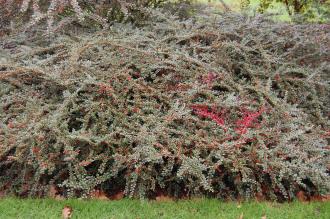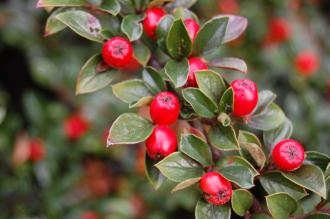
Cotoneaster moupinensis (21/10/2013, Kew Gardens, London)
Position: Full sun to dappled shade
Flowering period: Late spring to early summer
Soil: Moist, well drained
Eventual Height: 5m
Eventual Spread: 3m
Hardiness: 6b, 7a, 7b, 8a, 8b, 9a, 9b
Family: Rosaceae
Cotoneaster moupinensis is a deciduous shrub with bushy habit. Its dark green glossy leaves are elliptic with entire margins, up to 12mm long and 5mm broad. Its leaves turn bright red in autumn before they fall. Its pink flowers are up to 1cm across. Its fruit are a pome, initially red, maturing to black, up to 8mm across, mature in autumn and may be retained on the plant during the winter months.

Cotoneaster moupinensis Berries (21/10/2013, Kew Gardens, London)
Cotoneaster moupinensis, commonly known as Moupin Cotoneaster, is native to central China. In its native habitat it grows in thickets and woodland margins and stream sides. This species Cotoneaster of is becoming naturalised in parts of the UK and Europe.
The etymological root of the binomial name Cotoneaster is derived from the old Latin name cotone meaning ‘quince and aster being a Latin substantival suffix indicating ‘resembling’. Moupinensis is d
The landscape architect may find Cotoneaster moupinensis useful as a large specimen shrub with attractive autumn foliage. It may also be used an an informal hedge.
Ecologically, Cotoneaster moupinensis flowers are attractive to pollinating insects. Its berries are attractive to birds.

Cotoneaster moupinensis Autumn Leaf (21/10/2013, Kew Gardens, London)
Cotoneaster moupinensis prefers moist, fertile, well-drained soils. It tolerates most pH of soil.
Cotoneaster moupinensis requires little maintenance.

